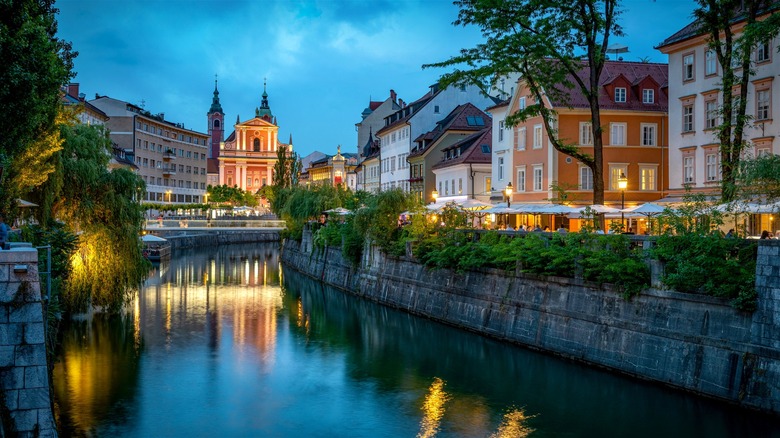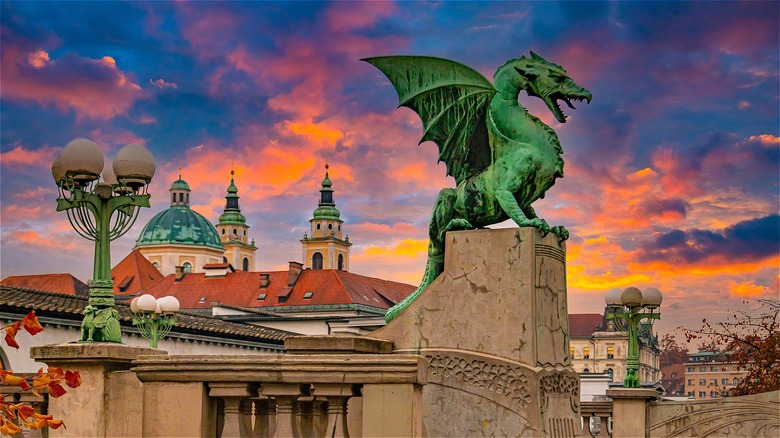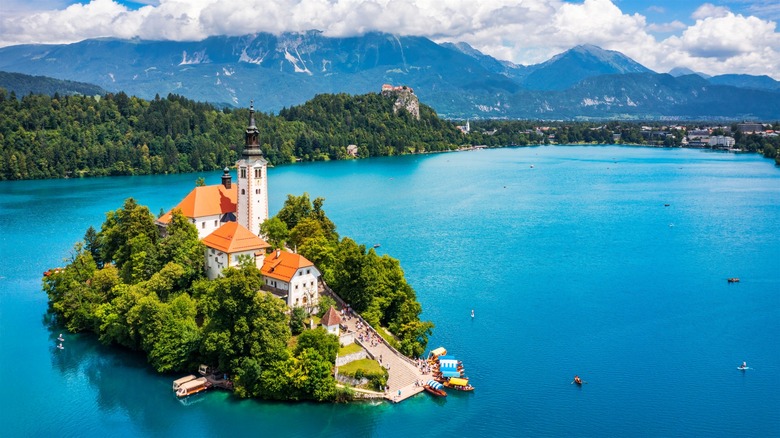The City In The Heart Of Europe That Remains A Relatively Undiscovered Delight, Per Rick Steves
Is Ljubljana on your European itinerary? It should be, according to Rick Steves. Ljubljana is the capital of Slovenia, a small Slavic nation and one of Europe's most unexpected charmers nestled between Italy to the west, Austria to the north, Croatia to the south, and Hungary to the east. A mix of German, Mediterranean, and Slavic culture, Ljubljana is an inviting blend of easygoing, small city life with a buzz of cafes, markets, and nightlife.
The city is conveniently located in the heart of Slovenia, a country that is slightly smaller than New Jersey but has only 2,133,000 people compared to the Garden State's 9,290,841. A low birth rate goes some way to explaining Slovenia's small populace, but the beautiful (though uninhabitable) mountains here also keep the nation's population density low.
The Julian Alps are within easy reach of Ljubljana, and among them is some of Slovenia's prettiest scenery. Areas here like the Logar Valley are as stunning as any in the Alps, with deep green valleys set against awesome snowy peaks and punctuated with quaint farming villages. About 62 miles west of the Logar Valley is Lake Bled, a magnificent glacial lake with a leafy island at its core that's home to the medieval Church of Mary the Queen. For something different, consider sticking to the city to better get to know one of Europe's safest and most welcoming countries.
Ljubljana, a low-key capital
Ljubljana's buildings are a reflection of its unique history. On his website, Rick Steves likens the capital's architecture to that of many other cities in the former Austro-Hungarian Empire and beyond, including Salzburg, Vienna, Belgrade, Prague, and Venice. Much of this splendor came about after 1895, when an earthquake devastated Ljubljana and caused a city-wide rebuild in the Art Nouveau and Art Deco styles.
In the 21st century, Ljubljana blends classic style with modern living. Much of the city center is pedestrianized, allowing people to stroll casually from bar to restaurant. You'll find the heart of Ljubljana's cafe culture along the Ljubljanica River, where one can take it easy with a drink in hand for hours. There's a busy market here, too, and the Open Kitchen street food festival (held weekly during the warm-weather months) offers a tempting breadth of local and international dishes.
Like most historic European cities, Ljubljana has a great bridge. In fact, it's got several of them. The quirky Triple Bridge was opened in 1842, and it provides three elegant stone crossings to the city's main square. The structure is Ljubljana's answer to Prague's Charles Bridge and it serves as a major meeting place for the city's residents and visitors, only with far fewer tourist traps. With so many fascinating landmarks, you shouldn't overlook this understated European capital, and you shouldn't cram it into a busy schedule, either. Rick Steves has met numerous people who regretted treating Slovenia and its main hub as quick pit stops. And remember, there are days' worth of adventure just outside the city.
Visit the beautiful Julian Alps nearby
Rick Steves appreciates the accessibility of the Julian Alps, which are only one to two hours from Ljubljana. Lake Bled is in the foothills and is one of the most picturesque scenes in the region, but locals enjoy much more than that. They love the many peaks, valleys, and rivers in this landscape, the most prominent feature of which is Mount Triglav, Slovenia's tallest mountain. Locals consider climbing this 9,396-foot peak a patriotic act, so you'll likely earn respect if you manage to conquer it.
It's easy to build a busy itinerary in the Julian Alps. Vintgar Gorge, for instance, has some of the lushest scenery in the region, with its rocks, rapids, and Šum Waterfall, which cascades for some 43 feet into an emerald pool below. For even greater falls, drive 30 miles southwest of Vintgar and hike around 90 minutes up to the 255-foot Savica Waterfall. There's no shortage of outdoorsy splendor here, and you'll skip the crowds of the Dolomites and other Alpine favorites.
The region's nature was an easy sell to Steves, but he was not expecting the local museums to be so interesting. After all, how interesting could the Beekeeping Museum be? Very, according to Steves, who described it as "unaccountably fascinating." Similarly appealing is the Loka Museum housed in Loka Castle, a 13th-century structure with stunning views from all angles. The museum hosts a variety of exhibits including taxidermy and local artwork through the centuries.


